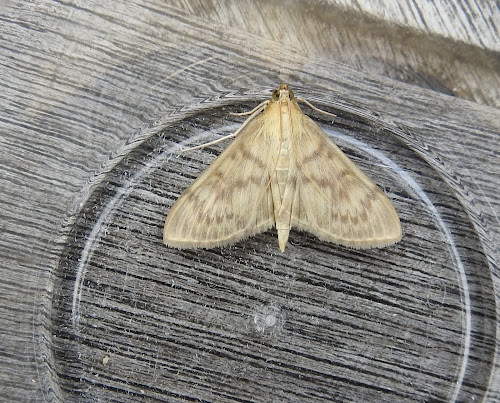I woke up to find plenty of moths in and around the trap, and have spent most of the day recording them. In a "here's one I prepared earlier" moment I should mention that the first Mother of Pearl of the year made it through the bathroom window on Thursday night.
 |
| Mother of Pearl |
It's the biggest micro there is, I think.
Moving on to this morning, I was up at stupid o'clock to check around the trap before hauling it into the house to see what was in it. This meant that no micros could escape before being identified and counted, and led to an excellent tally of 101 moths of 44 species, excluding one or two extremely worn ones which could have been anything.
At around 06.00 am I was outside trying to photograph something when I heard the unmistakable sound of Crossbills. I looked up and counted nine of them heading east, my second record this year. Its clearly a Crossbill year. The other notable bird event was an absence. The House Sparrows which have been a garden staple for months have disappeared completely. There is probably nothing too sinister in this, as they have almost certainly headed a mile or so east to feed in the local fields edges. I used to count hundreds in farmland at Bittell Reservoir at this time of year several decades ago.
I am reluctant to list all 44 species of moths caught, so will summarise. The top five in numbers were:
1. Garden Grass-veener - 13
2. Large Yellow Underwing - 9
3. Crambus pascuella - 9
4. Common Footman - 7
5. Eudonia lacustrata - 7
New for the garden (and for me) were a pristine micro and a rather worn macro. The former was a Brachmia blandella, which it is probably fair to say has subtle charms. The latter was uncommon enough to be excluded from the garden moths which the GMS survey would have me count, but is still regarded as fairly common in Warwickshire. That was a rather worn Slender Brindle.
 |
| Brachmia blandella |
 |
| Slender Brindle |
A further five were new for the year; Broad-bordered Yellow Underwing (2), Lesser Yellow Underwing, Yellow Shell, Dingy Footman, Agriphila straminella, and Horse-chestnut Leaf-miner. Of these, the leaf-miner was the first since 2018 (but they are so tiny they are easily missed), while the Dingy Footman was only my second record.
 |
| Broad-bordered Yellow Underwing |
 |
| Lesser Yellow Underwing |
 |
| Yellow Shell |
 |
| Dingy Footman |
 |
| Agriphila straminella |
 |
| Horse-chestnut Leaf-miner |
Honourable mentions should go to the second Cloaked Minor this year, the second Grey (or Dark) Dagger, the second Hedya salicella of the year (the previous one was horribly worn), and the second ever Batia lunaris.
 |
| Cloaked Minor |
 |
| Hedya salicella |
And finally, my struggles to pick out a Rustic from the numerous Uncertains which probably live in the garden, led me to choose this one as a likely Rustic.
 |
| Rustic |
I haven't asked for it to be checked because it gets a bit boring if you keep on with the same question every week, but I'm quietly confident its right.
No comments:
Post a Comment